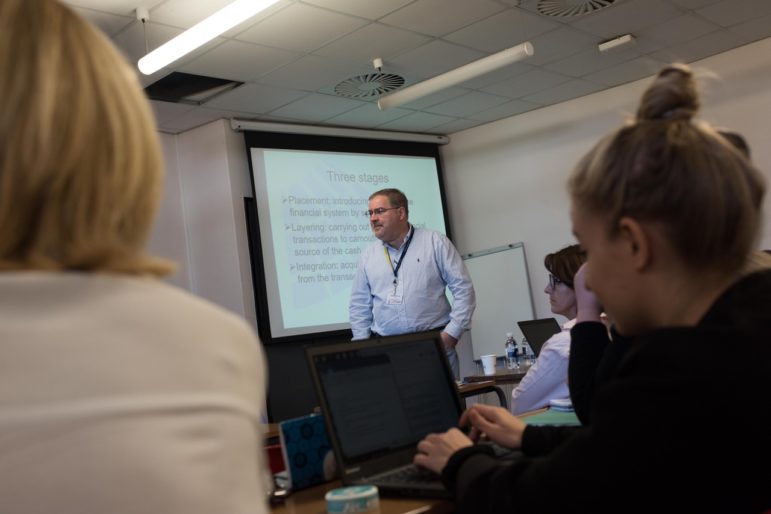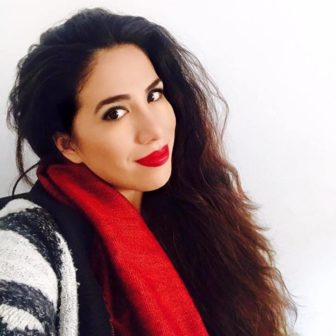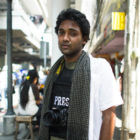
OCCRP’s Paul Radu at the Seven Financial Sins panel. Picture: Daylin Paul
Paul Radu, co-founder and executive director of the Organized Crime and Corruption Reporting Project (OCCRP), Drew Sullivan, co-founder and editor of OCCRP, and Miranda Patrucic, investigative reporter and editor of OCCRP distill the basics of money laundering, bribery and hiding assets at the 10th Global Investigative Journalism Conference in Johannesburg.
Financial Sin No. 1: Money Laundering
“Here’s the thing you’ve got to know about money laundering,” OCCRP’s Drew Sullivan said to a group of reporters. “You’ve got to paper it. If you’re sending $20 million to a bank they’re going to ask about the origin of the money being transferred.”
Money laundering is concealing the origins of illegally obtained funds through a number of methods, which can including offshore bank transfers, purchases of high value assets such as property, or legitimate businesses transactions that co-mingle dirty money, for example. Sullivan explained the three steps of money laundering: First, the dirty money is introduced into the financial system; second, the money is moved (or “layered”) through a number of complex transactions to camouflage its origins; and third, it is integrated by acquiring new ‘clean’ wealth produced from the laundered money.

Drew Sullivan at the Seven Financial Sins panel. Picture: Daylin Paul
Every transfer of money has to have a paper with it or some kind of document verifying its source. “It could be a contract, a trade deal, a court settlement or something like that,” Sullivan explained.
‘Laundromats’ are basic criminal structures created by banks and offshore entities. “What they do is basically set up these offshore companies into which they put the money,” Sullivan said.
Illicit funds can be laundered through real estate, the hawala system, put through cash-intensive businesses, or trade-based laundering, used to move value by over or undervaluing goods.
“The thing that makes this all possible is offshores,” Sullivan added, referring to corporations, trusts and other legal entities often used to mask true ownership.
“The banks receiving laundered cash are some of the biggest banks in the world,” said Paul Radu, as he recounted his work documenting more than 90,000 transactions with the Russian and Azerbaijani Laundromat projects. Banks are required to comply with anti-money laundering laws and regulations to identify suspicious activity. “The criminals count on the banks not doing their job.”
“We spoke to experts in these banks, compliance officers and people who should have seen this,” continued Radu. “Their argument is always ‘we can’t track down all these transactions because there are so many.’ But there’s a lot more we can do: we should be tracking down the banks.”
It’s not enough to chase all the global transfers, Radu explained. “One transaction takes weeks to analyze. The only way to clean up the banking sector is to analyze the ownership of the banks because these banks are ones that enable money laundering.”
Financial Sin No. 2: Bribery
“Bribery is a crime that takes place between two people and neither has an interest to expose it,” Sullivan said. “It’s very difficult to track down when somebody bribes somebody else. It’s a crime that’s very difficult to prove.”
He cited the case of Sergey Roldugin, Russian President Vladimir Putin’s childhood friend, from the Panama Papers.
“Roldugin owns some offshore companies that did a series of deals with other big Russian companies,” Sullivan said.
“These were companies that were very happy because of the business they received from Vladimir Putin—people like the Rotenbergs, who have the largest number of state contracts in the country.”
The leaks from Panamanian law firm Mossack Fonseca exposed that these large companies sold a share of their stock to Roldugin, but the sale contracts had no dates.
“If you can pick the date when you buy and sell a stock, you’re going to make a good profit,” Sullivan said.
He explained there were also questionable provisos on deals between the companies and Roldugin’s offshores. For example, conditions that said if a deal was started and cancelled, the offshore would receive a large sum of cash.
But there are various other ways bribes can be concealed.
Miranda Patrucic found in working on the Prodigal Daughter, investigating a major telecom bribery in Uzbekistan and Azerbaijan, that a family member of a president would be given the share of a company that was part of a joint venture with a foreign company in operating within the country. Then they would provide the foreign company with a put option, where they would receive a lot of money within a couple years.
“Another way the bribery was concealed is that the official’s relative’s company would own the telecom operating licenses and foreign companies would overpay for those licenses,” she said.
“Another thing I always look for if I’m investigating a major company is I look at all the subsidiaries and companies that have, for example, a 75 percent owner but then a remaining owner, an anonymous offshore, with 25 percent,” Patrucic added.
“I always want to find out who has the remaining shares.” This requires uncovering the true beneficial owners of the offshore company, which are designed to hide such information.
Patrucic also explained that she often found local registered companies within very corrupt countries that, in fact, did no business, but were found to be part of joint ventures or involved as business partners of foreign companies.
She said this is potentially a red flag, along with any notes in financial records detailing a ‘success fee,’ often a euphemism for a bribe.
Financial Sin No. 3: Hiding Ownership or Assets
“Once you’ve laundered the money, you’ve got these ill-gotten gains. So how do you go and hide that from other people?” asked Sullivan.
Patrucic said that often she sees a maze of offshore companies, but could sometimes obtain financial statements where the company lists its assets. The statements often contain details of payments or loans, and often properties.
“These statements tend to be found connected to local companies that aren’t offshores and they can be found in local registers,” she explained. The assets were held indirectly by close associates of their subject, so they would search their names on company registries.
She also emphasized the importance of social media in tracing assets. Patrucic told reporters that social media posts can be geolocated to track the assets.
“The subjects of our stories love to brag,” Patrucic said. “They show off their new house in London, luxury cars or their yacht. Social media is rich in information on where they stashed the cash.”
See the Tip Sheet for “Seven Financial Sins” courtesy of OCCRP here.
 Stella Roque is communications officer for OCCRP and Transparency International’s Global Anti-Corruption Consortium. Prior to joining OCCRP, she was a freelance writer and editor in Paris. She was also a researcher for The Centre for Investigative Journalism in London working with broadcast reporter Andrew Jennings on the FIFA corruption investigation.
Stella Roque is communications officer for OCCRP and Transparency International’s Global Anti-Corruption Consortium. Prior to joining OCCRP, she was a freelance writer and editor in Paris. She was also a researcher for The Centre for Investigative Journalism in London working with broadcast reporter Andrew Jennings on the FIFA corruption investigation.
 Daylin Paul is an independent photographer, visual journalist and photojournalism educator based in Johannesburg. He is the 2017 winner of the prestigious Ernest Cole Award for Photography for his ongoing documentary Broken Land and the 2017 Hostwriter Pitch Prize for Collaborative Journalism. His work has appeared in The New York Times, The Guardian, Foreign Policy, Financial Times and Huffington Post.
Daylin Paul is an independent photographer, visual journalist and photojournalism educator based in Johannesburg. He is the 2017 winner of the prestigious Ernest Cole Award for Photography for his ongoing documentary Broken Land and the 2017 Hostwriter Pitch Prize for Collaborative Journalism. His work has appeared in The New York Times, The Guardian, Foreign Policy, Financial Times and Huffington Post.
